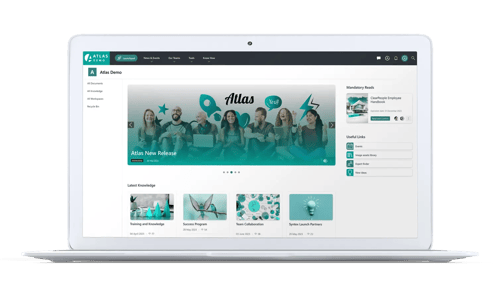What is the difference between out-of-the-box intranets and SharePoint intranets? When choosing an intranet solution, organizations often find themselves weighing the pros and cons of out-of-the-box intranets versus SharePoint intranet. This blog aims to clarify the key differences between these two options, helping you make an informed decision for your business.
In this blog we cover:
What are out-of-the-box intranets?
Out-of-the-box intranets are pre-configured, ready-to-use solutions designed to meet the basic needs of most organizations without extensive customization. These intranets are developed with user-friendly interfaces and built-in functionalities, making them quick to deploy and easy to maintain. Common examples include Jive, Valo, and Igloo.
Key features of out-of-the-box intranets
- Ease of implementation: These solutions can be deployed quickly, often within days or weeks, with minimal IT involvement.
- Predictable costs: Typically, out-of-the-box intranets have predictable pricing models.
- User-friendly: Often these intranets offer intuitive interfaces and straightforward navigation.
- Pre-built templates: They come with a variety of pre-designed templates and layouts, allowing for quick setup and branding.
- Basic functionality: Out-of-the-box intranets cover essential features for communication.
Limitations of out-of-the-box intranets
- Limited customization: These solutions may not offer the flexibility needed to cater to specific business requirements or workflows.
- Scalability issues: As your organization grows, you may find that an out-of-the-box intranet cannot scale adequately to meet your needs.
- Integration challenges: Integrating with other enterprise systems and applications can be difficult and sometimes impossible.
Microsoft SharePoint as intranet
Microsoft SharePoint is one of the most popular intranet tools. SharePoint, a product of Microsoft, is a highly customizable platform widely used for building intranets. SharePoint intranets are renowned for their flexibility, scalability, and deep integration capabilities with other Microsoft 365 tools, such as Teams, Outlook, and OneDrive.
Key features of SharePoint intranets
Some of the key features are:
- Customizability: SharePoint allows extensive customization to meet specific business needs, from layout and design to workflows and permissions.
- Integration: Seamlessly integrates with Microsoft 365.
- Scalability: SharePoint can scale from small teams to large enterprises, accommodating growth and increasing complexity.
- Security: Robust security features ensure data protection, compliance, and governance.
- Advanced Features: Offers advanced functionalities like business process automation, advanced search, and custom applications.
What is out-of-the-box in SharePoint? And what are its limitations?
SharePoint out-of-the-box (OOTB) delivers basic intranet features. However, it has its limitations, including:
- Complex Implementation: Deploying a SharePoint intranet requires significant planning, customization, and IT expertise, which can be time-consuming.
- Higher Costs: The flexibility and advanced features come at a higher cost, including customization expenses, and ongoing maintenance.
- Learning Curve: Users may require training to fully leverage SharePoint’s capabilities, which can slow down adoption.
- Complex to maintain. The platform was built to be customized.
- Targeting of content is basic.
- Branding and user experience options are limited.
- Templating, provisioning and governance is not automated and therefore prone to errors.
Key differences between Out-of-the-Box and SharePoint intranets
Customization vs. standardization
- Out-of-the-Box: Offers limited customization, focusing on standard features that work for most organizations.
- SharePoint: Highly customizable to meet specific business needs, from custom workflows to unique site designs.
Deployment time and complexity
- Out-of-the-Box: Quick and straightforward deployment with minimal IT involvement.
- SharePoint: Requires more time and expertise for planning, customization, and implementation.
Cost considerations
- Out-of-the-Box: Generally more cost-effective.
- SharePoint: Higher initial and ongoing costs due to customization, and maintenance.
Integration capabilities
- Out-of-the-Box: Limited integration options with other enterprise systems.
- SharePoint: Seamless integration with Microsoft 365.
Scalability and Flexibility
- Out-of-the-Box: May face scalability challenges as your organization grows.
- SharePoint: Designed to scale with your business, accommodating growing teams and complex requirements.
Out-of-the-box intranet software providers vs SharePoint and Microsoft 365
Some out-of-the-box intranet software providers are quick to pick holes in the perceived limited features and functionality of SharePoint.
A flaw in these criticisms though is that they generally don't specify the edition of SharePoint they're describing.
To respond to this, ClearPeople have evaluated both SharePoint Online and Microsoft 365 against the criteria some well-known out-of-the-box intranet software providers list.
Conclusion: Choosing the right intranet for your business
The choice between an out-of-the-box intranet and a SharePoint intranet depends on your organization’s specific needs, budget, and growth plans.
- If you need a quick communications intranet, an out-of-the-box intranet might be the right choice.
- If your organization requires a highly customizable and scalable platform, a SharePoint intranet is likely the better option.
- If your organization requires a scalable platform that can be deployed quickly and is integrated seamlessly with Microsoft 365 and other enterprise apps, then read more about Atlas below.
By understanding the differences and evaluating your business requirements, you can choose an intranet solution that enhances collaboration, boosts productivity, and supports your organizational goals.
SharePoint out-of-the-box vs Atlas Knowledge Intranet

For modern businesses, a SharePoint intranet is not enough.
Atlas is an intelligent knowledge platform built on top of Microsoft 365. Think of it as the "Wikipedia for the enterprise" when searching for authoritative information. It combines the capabilities of a traditional intranet with advanced knowledge management features to revolutionize how organizations manage, share, and discover information.
> Read more about SharePoint out-of-the-box vs Atlas Digital Workplace

